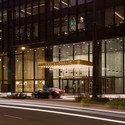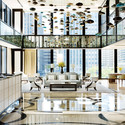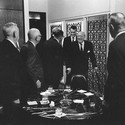
ArchDaily is continuing our partnership with The Architectural Review, bringing you short introductions to the themes of the magazine’s monthly editions. In this editorial from AR’s February 2015 issue, AR Editor Catherine Slessor reflects on Álvaro Siza's ouevre, from his early work in Évora to his latest effort in China. Though the latter is admittedly elegant, Slessor concludes that in comparison to his older transformative designs the recent incarnation of "brand Siza" is a "predictable triumph of style over content."
The great Portuguese Modernist Fernando Távora once remarked "Style is not of importance; what counts is the relation between the work and life, style is only the consequence of it." His friend and protégé Álvaro Siza echoed this sentiment when he said: "Architecture does not have a pre-established language nor does it establish a language. It is a response to a concrete problem, a situation in transformation, in which I participate. In architecture, we have already passed the phase during which we thought that the unity of language would resolve everything. A pre-established language, pure, beautiful, does not interest me."




























.jpg?1424277398)
.jpg?1424277374)
.jpg?1424277349)


![Runner Up [4]: Entrance View. Image Courtesy of UNESCO UNESCO Reveals Winning Scheme For The Bamiyan Cultural Centre In Afghanistan - Image 1 of 4](https://images.adsttc.com/media/images/54e5/a053/e58e/cec9/5100/00d7/thumb_jpg/Screen_Shot_2015-02-19_at_09.37.32.jpg?1424334925)
![Runner Up [2]: Performance Space. Image Courtesy of UNESCO UNESCO Reveals Winning Scheme For The Bamiyan Cultural Centre In Afghanistan - Image 2 of 4](https://images.adsttc.com/media/images/54e5/9dbf/e58e/ce21/e000/00ec/thumb_jpg/Screen_Shot_2015-02-19_at_09.23.41.jpg?1424334253)
![Runner Up [1]: Interior Perspective. Image Courtesy of UNESCO UNESCO Reveals Winning Scheme For The Bamiyan Cultural Centre In Afghanistan - Image 3 of 4](https://images.adsttc.com/media/images/54e5/9c61/e58e/cec9/5100/00d2/thumb_jpg/Screen_Shot_2015-02-19_at_09.20.38.jpg?1424333911)
![Runner Up [3]: Elevation. Image Courtesy of UNESCO UNESCO Reveals Winning Scheme For The Bamiyan Cultural Centre In Afghanistan - Image 4 of 4](https://images.adsttc.com/media/images/54e5/a213/e58e/cef2/f400/00d7/thumb_jpg/Screen_Shot_2015-02-19_at_09.43.29.jpg?1424335371)















